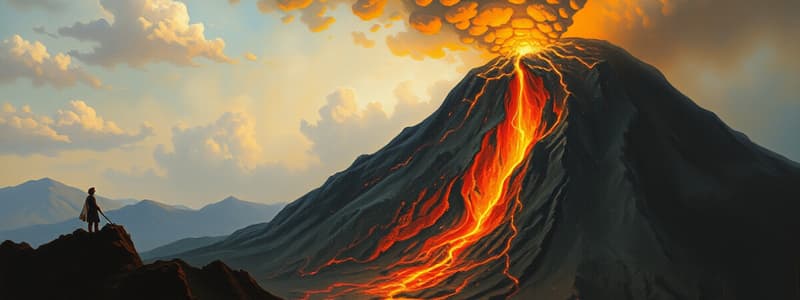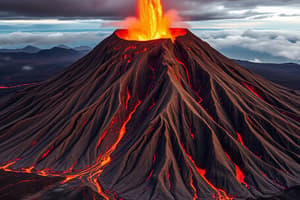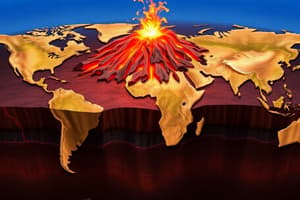Podcast
Questions and Answers
What are volcanoes?
What are volcanoes?
Volcanoes are vents in Earth's surface through which molten rock pours.
How are volcanoes formed?
How are volcanoes formed?
Most volcanoes occur where two plates meet.
What is magma?
What is magma?
Molten rock beneath the surface.
What is lava?
What is lava?
What is the ring of fire?
What is the ring of fire?
Where do volcanoes form?
Where do volcanoes form?
Why do volcanoes form on land?
Why do volcanoes form on land?
Why do volcanoes form underwater?
Why do volcanoes form underwater?
Where do volcanic belts form?
Where do volcanic belts form?
Where/why do volcanoes form along mid-ocean ridges?
Where/why do volcanoes form along mid-ocean ridges?
The lava gradually builds up what?
The lava gradually builds up what?
What is an island arc?
What is an island arc?
How does a volcano form because of subduction?
How does a volcano form because of subduction?
What is a hot spot?
What is a hot spot?
How do hot spots form?
How do hot spots form?
What types of crust collide to create converging volcanoes?
What types of crust collide to create converging volcanoes?
Study Notes
Volcanoes Overview
- Volcanoes are openings in Earth's surface where molten rock, or magma, can escape to the surface.
- They typically form at convergent plate boundaries where one tectonic plate subducts beneath another.
Formation of Volcanoes
- Most volcanoes occur at the junction of two tectonic plates.
- When plates diverge, lava rises to fill gaps, often forming underwater volcanoes that can be invisible.
- Plate collisions create pressure in the Earth’s crust, leading to the melting of the subducted plate, which results in volcanic formation.
Key Terms
- Magma: Molten rock located beneath the Earth's surface.
- Lava: Magma that has reached Earth's surface.
Locations of Volcanoes
- Volcanoes primarily form at convergent and divergent plate boundaries, as well as hot spots.
- Volcanic belts typically develop along plate boundaries.
Underwater Volcanoes
- Underwater volcanoes can form through plate collisions (subduction) or when plates separate, allowing lava to escape.
Mid-Ocean Ridges
- Volcanoes develop along mid-ocean ridges where rift valleys allow magma to rise.
Formation Processes
- Gradual accumulation of lava over time leads to the formation of mountains.
- An island arc is created from a series of volcanic islands formed along deep ocean trenches.
Subduction Process
- During subduction, magma is generated in the upper mantle, rising through crustal cracks due to its lower density compared to surrounding crustal materials.
Hot Spots
- A hot spot is a stationary area on the Earth's surface with prolonged high volcanism, resulting from plumes of hot magma from the mantle.
- Heat from Earth’s core contributes to the formation of hot spots.
Types of Crust Interactions
- Converging volcanoes often result from the collision of oceanic crust with either oceanic or continental crust.
Studying That Suits You
Use AI to generate personalized quizzes and flashcards to suit your learning preferences.
Description
Explore the fascinating world of volcanoes in this quiz, which covers their formation, locations, and the geological processes behind them. Learn about the types of volcanoes, the significance of magma and lava, and the role of tectonic plates in volcanic activity.



